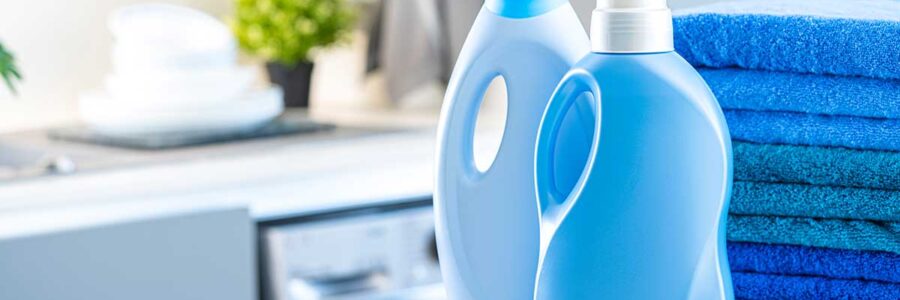Laundry might seem like a simple chore, but the products we use to clean our clothes can have complex and far-reaching effects on our health. Many laundry detergents available today contain chemicals that do more than just remove dirt—they can harm your health in ways you might not even realize.
This article will examine the hidden dangers of traditional laundry detergents and provide a step-by-step guide to creating your non-toxic alternative.
The Toxic Truth About Traditional Laundry Detergents
1,4-Dioxane: Classified as a probable human carcinogen by the U.S. Environmental Protection Agency (EPA), 1,4-dioxane is a chemical byproduct found in many conventional laundry detergents. It doesn’t have to be listed on product labels, making it difficult for consumers to avoid it. This chemical can penetrate the skin, and prolonged exposure is linked to increased risks of liver and kidney damage, as well as cancer.[1]
Phosphates: Phosphates are used in detergents to soften water and improve cleaning efficiency, but they come with a heavy environmental and health toll. When phosphates enter waterways, they promote excessive growth of algae, which depletes oxygen and harms aquatic life. For humans, phosphates can irritate the skin and respiratory system, and they’ve been linked to an increased risk of cardiovascular disease when they accumulate in the body over time.[2]
Surfactants: Surfactants are responsible for detergents’ foaming action and ability to break down oils and grease. However, many surfactants used in traditional detergents, such as alkylphenol ethoxylates (APEs), are known endocrine disruptors. These chemicals can mimic hormones in the body, leading to reproductive issues, developmental delays, and an increased risk of cancers like breast cancer.[3]
Phthalates: Often used to add fragrance to laundry detergents, phthalates are another group of chemicals with significant health risks. Phthalates can interfere with hormone production and are linked to asthma, allergies, and reproductive problems, particularly in developing fetuses. Because they are not required to be listed individually on product labels, it’s challenging to avoid them unless you switch to fragrance-free or naturally scented-products.[4]
Synthetic Dyes: Synthetic dyes are often used to achieve the bright, eye-catching colors of many laundry detergents. While these dyes might seem harmless, they can cause skin irritation and allergic reactions, particularly in people with sensitive skin. Some synthetic dyes have also been linked to cancer, although the evidence is still emerging.
How These Chemicals Affect Your Health
These toxic chemicals don’t just wash away when your laundry is done. They linger on your clothes, bedding, and towels, coming into contact with your skin throughout the day and night. Over time, repeated exposure to these chemicals can lead to a buildup of toxins in your body, which can cause or exacerbate a range of health issues, including:
- Skin irritation and allergies: Many of the chemicals in traditional detergents can cause dermatitis, rashes, and other skin problems, particularly in individuals with sensitive skin or allergies.
- Respiratory problems: Inhaling the fumes from laundry detergents, especially during washing and drying, can irritate the lungs and exacerbate asthma.
- Hormonal disruptions: Endocrine disruptors found in many detergents can interfere with the body’s natural hormone production, leading to reproductive issues, developmental problems, and an increased risk of hormone-related cancers.
- Long-term health risks: The accumulation of toxic chemicals in the body over time can contribute to chronic health issues, including liver and kidney damage, cardiovascular disease, and cancer.
A Healthier Alternative: DIY Non-Toxic Laundry Detergent
The good news is that you don’t have to settle for toxic laundry products. Making your detergent is not only healthier for you and your family, but it’s also easy and cost-effective. Here’s a simple recipe to get you started.
Ingredients:
- 1.5 cups baking soda: Baking soda is a natural cleaner and deodorizer that helps to neutralize odors and remove stains.
- 1.5 cups washing soda: Washing soda is a powerful cleaning agent that works to lift dirt and grime from fabrics.
- 1/4 cup sea salt: Sea salt enhances the cleaning power of the other ingredients and helps soften hard water.
- 1/2 cup Epsom salt: Epsom salt acts as a natural fabric softener and helps to eliminate detergent residue from clothes.
- Optional: 20 drops of organic lemon essential oil: Lemon essential oil adds a refreshing scent and provides natural antibacterial properties.
References:
- Wilbur, Sharon, et al. “PUBLIC HEALTH STATEMENT.” Toxicological Profile for 1,4-Dioxane, Agency for Toxic Substances and Disease Registry (US), 2012.
- Lim, Chris C., et al. “Harmful Algal Bloom Aerosols and Human Health.” eBioMedicine, vol. 93, July 2023.
- Bernal-Jácome, Luis Armando, et al. “Nonylphenol Ethoxylate Degradation in Detergents during Shelf Time, a New Exposure Pathway, and a Perspective on Their Substitution.” Environmental Science and Pollution Research International, vol. 31, no. 21, May 2024, pp. 30497–508. PubMed.
- Wang, Yufei, and Haifeng Qian. “Phthalates and Their Impacts on Human Health.” Healthcare, vol. 9, no. 5, May 2021, p. 603. PubMed Central.


